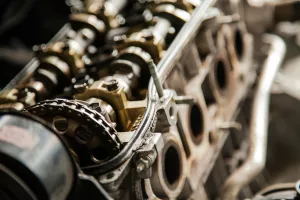Owning a car is a significant milestone, offering freedom and convenience, but it also comes with responsibilities. Regular car maintenance is essential to ensure your vehicle’s safety, reliability, and longevity. For new drivers, maintaining a car may seem intimidating, but with a few essential tips and tricks, you can keep your car in excellent condition without being a mechanic.
This guide will walk you through 15 simple car maintenance tips and tricks tailored for beginners. Whether you’re a first-time driver or looking to improve your car care routine, these practical insights will help you maintain your vehicle with confidence.
1. Check and Change Your Oil Regularly
The engine oil in your car plays an indispensable role in maintaining the health and efficiency of your engine. Acting as a lubricant, it reduces friction between moving parts, preventing excessive wear and tear. It also helps to dissipate heat generated by the engine, preventing overheating. Additionally, engine oil traps dirt, debris, and other contaminants, keeping the engine clean and operating smoothly. Without clean and sufficient oil, your engine can seize up, leading to costly repairs or even total engine failure.
Why Checking Your Oil Matters
Checking your oil regularly ensures that your engine is running with the right amount and quality of oil. Driving with low or dirty oil can cause parts to grind against each other, leading to overheating and permanent damage. By keeping an eye on your oil, you can detect potential problems early, such as oil leaks or excessive oil consumption, both of which may indicate deeper mechanical issues.
For beginners, learning how to check oil is an easy and essential skill that helps build confidence in car maintenance. Not only does it save money by preventing unnecessary damage, but it also gives you peace of mind on the road.
Step-by-Step Guide to Checking Your Oil
- Park on Level Ground: Ensure your car is parked on a flat surface to get an accurate reading. An uneven surface can tilt the oil pan, resulting in incorrect measurements.
- Let the Engine Cool: Always check your oil when the engine is cold or after it has been off for at least 10 minutes. Hot oil expands and may give a false reading.
- Locate the Dipstick: Open the hood and look for the dipstick, which typically has a brightly colored handle (yellow or orange). Your owner’s manual can help you identify its location if needed.
- Remove and Wipe the Dipstick: Pull the dipstick out completely and wipe it clean with a cloth or paper towel to remove any oil residue.
- Reinsert and Remove the Dipstick Again: Push the dipstick back into its tube until fully seated, then pull it out to check the oil level.
- Examine the Oil Level and Color: The dipstick has markings (usually “MIN” and “MAX”) to indicate the acceptable oil range. The oil level should fall between these marks. Additionally, check the color of the oil: clean oil is amber and transparent, while dirty oil appears dark and sludgy.
When and How to Change Your Oil
If the oil level is low, top it off with the appropriate type of oil specified in your owner’s manual. However, if the oil is dirty or has not been changed within the recommended interval, it’s time for an oil change. Regular oil changes are critical to maintaining engine health.
For most older cars, the oil should be changed every 3,000 to 5,000 miles, but newer vehicles often allow for intervals of 7,500 to 10,000 miles. Advances in oil technology and engine design have extended these intervals, but adhering to your manufacturer’s recommendations is crucial.
Steps to Change Your Oil
Changing your car’s oil is a relatively simple DIY task if you’re up for it:
- Gather Tools and Supplies: You’ll need a wrench, oil filter wrench, oil pan, funnel, and the correct type and amount of oil.
- Drain the Old Oil: Place the oil pan under the drain plug, unscrew the plug, and let the old oil flow out completely.
- Replace the Oil Filter: Unscrew the old oil filter, replace it with a new one, and ensure it is tightly secured.
- Add New Oil: Using a funnel, pour in the recommended amount of new oil. Afterward, check the dipstick to ensure the level is correct.
- Dispose of Old Oil Properly: Take the used oil to a recycling center or an auto shop that accepts oil waste.
2. Keep Your Tires in Good Shape
Proper tire maintenance ensures safety, improves fuel efficiency, and extends tire life. Regularly check the tire pressure using a tire gauge and inflate them to the manufacturer’s recommended levels. You can find this information in the owner’s manual or on a sticker inside the driver’s door.
Additionally, inspect your tires for wear and tear, including uneven tread wear or bulges, which may indicate alignment or suspension issues. Rotate your tires every 5,000 to 7,500 miles to promote even wear, and replace them when the tread depth falls below 2/32 of an inch.
3. Replace Windshield Wipers When Needed
Windshield wipers are vital for maintaining visibility during rain or snow. Over time, wiper blades can become worn, cracked, or ineffective. Inspect them regularly and replace them every six months to a year, or sooner if you notice streaking or squeaking.
Replacing wiper blades is a simple DIY task. Most modern wipers come with installation instructions, and no tools are required. Make it a habit to top off the windshield washer fluid while checking the wipers for optimal performance.
4. Inspect and Replace Air Filters
Your car’s air filters—both the engine air filter and the cabin air filter—play crucial roles in maintaining performance and air quality. The engine air filter prevents dirt and debris from entering the engine, while the cabin air filter ensures clean air inside the car.
Check the filters every 12,000 to 15,000 miles, or as recommended in your owner’s manual. Replacing them is often as simple as popping open a housing compartment, removing the old filter, and inserting a new one. Clean air filters improve fuel efficiency and prolong engine life.
5. Test and Replace Your Battery
A dead battery can leave you stranded, so it’s essential to keep your car battery in good condition. Inspect the battery terminals for corrosion, which appears as a white or bluish powder, and clean them with a mixture of baking soda and water if needed.
Test your battery regularly, especially before winter or long trips. Most auto parts stores offer free battery testing. Replace the battery every three to five years or if it fails to hold a charge.
6. Pay Attention to the Brakes
Your brakes are critical for safety, so never ignore signs of wear or damage. Listen for squeaking, grinding, or squealing noises, which may indicate worn brake pads. If the car pulls to one side when braking or if you feel vibrations in the brake pedal, it’s time for an inspection.
Brake pads typically need replacement every 25,000 to 70,000 miles, depending on your driving habits and the type of pads. Consult a professional mechanic for brake maintenance and repairs.
7. Check All Fluid Levels
Beyond engine oil, your car relies on several other fluids to function properly:
- Coolant: Prevents the engine from overheating.
- Transmission Fluid: Ensures smooth shifting.
- Brake Fluid: Enables effective braking.
- Power Steering Fluid: Aids in steering control.
- Windshield Washer Fluid: Keeps your windshield clean.
Regularly check these fluids according to your owner’s manual and top them off as needed. Look out for leaks, as low fluid levels can lead to significant damage.
8. Monitor the Check Engine Light
The check engine light on your dashboard is a signal from your car’s onboard diagnostic system, indicating that something is amiss. While the problem could be minor, such as a loose gas cap, it might also point to more serious issues like engine misfires or sensor failures.
Don’t ignore the light. Use an OBD-II scanner (available at most auto stores or online) to identify the error code or visit a mechanic for a diagnostic check. Addressing issues promptly can prevent costly repairs down the line.
9. Maintain the Cooling System
The cooling system, including the radiator, coolant, and hoses, prevents your engine from overheating. Regularly check the coolant level and ensure the radiator cap is secure. Inspect hoses for cracks or leaks and replace them if necessary.
Flush and replace the coolant every 30,000 miles or as recommended by your vehicle manufacturer. This helps prevent corrosion and keeps the system running efficiently.
10. Keep Your Lights in Working Order
Functioning headlights, taillights, brake lights, and turn signals are essential for visibility and safety. Periodically check all lights by turning them on and walking around the car to ensure they are functioning properly.
Replace burned-out bulbs promptly, as driving without functioning lights can result in fines and reduced safety. If your headlights appear foggy or yellowed, clean them with a headlight restoration kit for better visibility.
10. Learn to Change a Flat Tire
Flat tires can happen unexpectedly, and knowing how to change one is an essential skill for any driver. While roadside assistance is helpful, being prepared to handle a flat tire yourself can save time and stress in emergencies.
Make sure your car is equipped with a spare tire, jack, and lug wrench. These tools are typically included with most vehicles, but double-check their condition regularly. Practicing the process in a safe location, such as your driveway, can help you feel confident when the need arises.
When changing a tire:
- Park Safely: Choose a flat, stable surface and engage the parking brake. Use hazard lights to alert other drivers.
- Loosen Lug Nuts: Use the lug wrench to loosen the nuts slightly while the tire is still on the ground.
- Raise the Car: Position the jack under the car’s designated lifting point and raise it until the flat tire is off the ground.
- Swap Tires: Remove the lug nuts, take off the flat tire, and replace it with the spare. Hand-tighten the lug nuts evenly.
- Lower and Tighten: Lower the car and tighten the lug nuts in a star pattern to ensure even pressure.
Spare tires, especially compact ones, are temporary solutions. Avoid driving long distances or exceeding the recommended speed until you replace the spare with a full-size tire.
12. Keep Your Car Clean Inside and Out
Regular cleaning not only makes your car look good but also helps maintain its condition. Wash the exterior to remove dirt, salt, and debris that can cause rust. Wax the car every few months to protect the paint and enhance its shine.
Inside the car, vacuum the seats and carpets, wipe down surfaces, and clean the windows for better visibility. Use organizers to keep the interior tidy and clutter-free.
13. Follow Your Car’s Maintenance Schedule
Your owner’s manual contains a maintenance schedule tailored to your specific vehicle. This schedule outlines when to perform essential tasks such as oil changes, tire rotations, and brake inspections. Following it ensures your car remains in optimal condition and prevents unnecessary repairs.
Regular maintenance checks also help maintain your car’s resale value and ensure compliance with warranty requirements.
14. Protect Your Car from Weather Damage
Extreme weather conditions can take a toll on your vehicle. In winter, use a windshield cover to prevent ice buildup and consider using snow tires for better traction. In summer, park in the shade or use a sunshade to protect the interior from heat and UV damage.
Applying a protective wax coating before winter can shield your car’s paint from road salt and snow. Always wash your car after exposure to salt or mud to prevent rust.
15. Don’t Ignore Unusual Noises or Smells
Strange noises or smells often indicate underlying problems. For example:
- Squealing: Worn belts or brake pads.
- Grinding: Transmission or brake issues.
- Burning Smell: Oil leaks or overheating components.
- Gasoline Odor: Fuel system leaks.
Address these signs promptly to prevent further damage. A trusted mechanic can help diagnose and resolve issues, ensuring your car remains safe and reliable.
Conclusion
Maintaining a car doesn’t have to be overwhelming, even for beginners. By following these 15 tips and tricks, you can keep your vehicle in excellent shape, improve safety, and save money on repairs. Regular maintenance not only prolongs the life of your car but also ensures a smoother and more enjoyable driving experience.
Start small, stay consistent, and remember that caring for your car is an investment in its performance, reliability, and value. With time and practice, car maintenance will become second nature, giving you confidence as a responsible driver.




